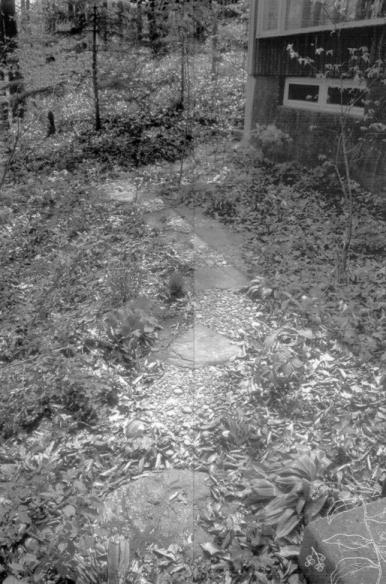Naturalizing your city backyard
- A visit with Larry Lamb
by Walter Muma
In May of 2001 I had the opportunity to visit the property of
Larry Lamb along with other members of the local naturalists club,
the Kitchener-Waterloo Field Naturalists.
Each person who naturalizes their property has their own approach to it, and
Larry is no exception.
Overall Philosophy:
His goal is to return his half-hectare of land to the way it was before human
interference. He wants to leave it in better condition than when he moved
there.
All people who set out to naturalize their property are faced with the
question of what natural habitat they are seeking to emulate or recreate.
Part of this question involves choosing what plants to place into and encourage
in the naturalized area. Larry has chosen to grow only plants that
naturally and natively occur within a 10 mile radius of his home (which is the
property that he is naturalizing). This is an arbitrary scope, almost a number
that he has picked out of the air. He wanted to choose a radius that was
neither too broad in order to avoid diluting local genetic stock, nor too
narrow.
He obtains plants from plant rescues and collects and scatters seeds.
Front yard:
|

Photo by Larry Lamb
|
The front yard has required much more work than the
back. More non-native species had been planted by the former owners than
in the backyard. |
He has pulled up all the daylillies and periwinkles. He notes that the
periwinkle still comes up, and he expects it to for a few years to come.
It is difficult to eradicate. Herbicides such as Roundup do not work very well
on periwinkle (For more information on roundup and other pesticides see www.panna.org
- Pesticide Action Network North America). To replace these groundcovers he has planted a number of woods
type plants. He recommends Virginia waterleaf and creeping stawberrybush as
groundcovers that spread quickly. The creeping strawberrybush is very
competitive however, and may crowd out other species in the long run.
He has also planted wild strawberry and columbine, as well as many other
species to fill in the area.
Larry has been emphasizing shrubs and trees that provide winter colour.
Colour in the autumn as provided by leaves changing colour. Colour in the winter
provided by evergreens (spruce and hemlock) and shrubs that have coloured stems,
such as the red stems of dogwood. And in the lower areas, ferns that retain
their leaves through the winter, such as Christmas fern.
He is leaving some foreign trees and shrubs for the time being as shelter and
screening from the street, while native replacements grow up.
There is a small island in the middle of the street outside of his
house. With permission of the city and the neighbours he has begun
naturalizing it as well. Back yard:
|

Photo by Larry Lamb
|
The backyard is a woods area, bordered by some wetlands.
Here Larry has adopted a fairly hands-off approach to naturalizing.
The only exceptions are that he removes alien species and only introduces
species that occur in the immediate area. Everything else he is
allowing to grow as it naturally does. In fact, he even takes great
care not to disturb the area in any way, taking care to not even walk much
through the area. He noted how even one person walking through can
leave signs that last for months.
However, the area required substantial initial work --
he removed approximately 2000 European buckthorns, as well as many other
foreign invasive species!
Leatherwood is common in the backyard.
|
There is also an article by Larry Lamb on his naturalizing efforts in the
Spring 2001 issue of Wildflower magazine, and is reproduced on this website: Severing
Roots.
Larry Lamb has written other articles on plants which appear
on this website. See the Naturalization and Alien Plants sections.
Larry
Lamb is the Manager of the Environmental Studies Ecology Laboratory at the
University of Waterloo (Ontario,
Canada) and an Adjunct Lecturer. He is well-known as a vocal and passionate advocate for
native plants. |